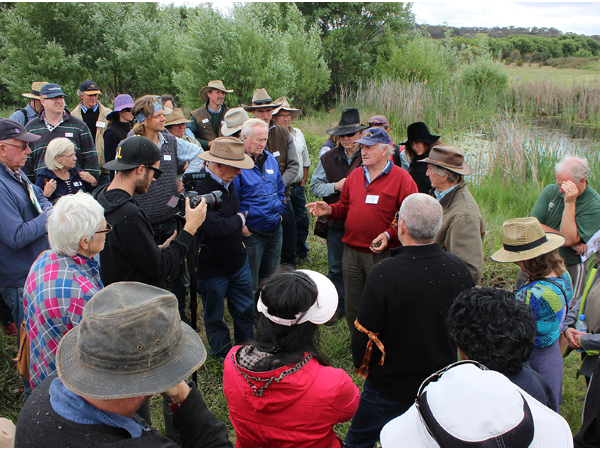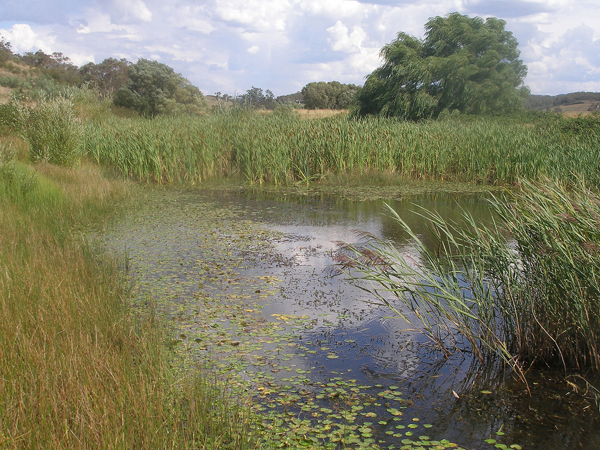Building catchment and community resilience at Mulloon
By the Mulloon Institute
Independent landscape thinker Peter Andrews recently walked a section of the Mulloon Creek in New South Wales to help with planning for the Mulloon Community Landscape Rehydration Project (MCLRP).
Peter is a master in reading the landscape, with a lifetime of experience in healing and rejuvenating degraded agricultural landscapes across Australia. He approaches landscape repair by harnessing a landscape’s natural patterns and processes to restore its function and resilience, allowing the land to flourish even in times of drought.
The Mulloon Community Landscape Rehydration Project aims to rebuild the Mulloon Catchment’s natural landscape function and boost its resilience against climatic extremes, leading to more reliable stream flows, improved ecosystem functioning and enhanced agricultural productivity.

Peter Andrews talking with landholders.
Located 40 minutes east of Canberra, the project spans 23,000 hectares with 40 kilometres of creeks and tributaries, and represents a major up-scaling of the successful Natural Sequence Farming pilot at nearby Mulloon Creek Natural Farms.
The Mulloon Catchment forms part of Sydney’s drinking water supply system, and the project provides a critical biodiversity corridor connecting Tallaganda National Park with the Mid-Shoalhaven Water Catchment’s protected lands.
Implementation
MCLRP is being implemented by The Mulloon Institute – a research, education and advocacy organisation that actively demonstrates, monitors and shares regenerative methods of land management.
A major focus of the project is creek repair and erosion control using small interventions to slow and filter water flow, preventing further erosion and beginning to rebuild the soil.
Importantly, it also aims to recharge shallow aquifers in the adjoining floodplain which have dried out from nearly 200 years of erosion. This provides critical moisture for flora and fauna to thrive and builds catchment resilience during drought conditions.
Interventions in the creek are made using natural materials found onsite and are complimented by holistic agricultural and landscape management practices along the creek, including sustainable grazing, fencing, tree planting, slope stabilisation and contouring.

Mulloon Creek has been transformed into a vibrant ecosystem (2013).
Flow-on Effects From an Improved Catchment
Much has changed over the 11 years since initial construction of the Natural Sequence Farming pilot at Mulloon Creek Natural Farms.
The floodplain pocket is now 60 percent more productive, and the creek has been transformed into a healthy, vibrant ecosystem, filtering water through its extensive reed beds, capturing flood sediments, recycling nutrients and providing complex habitat for birds, mammals, reptiles, frogs, fish and invertebrates.
The wider Mulloon Catchment has also benefited with improvements in water quality, water yield, and enhanced biodiversity resulting from tackling soil erosion, habitat fragmentation and weed proliferation.
Community participation has expanded to 20 landholders across the catchment, bringing neighbours closer together to share ideas and knowledge, and creating a greater sense of community cohesion and well-being.
Landholders can also better appreciate their property’s place in the broader landscape, and how it influences and is influenced by the entire catchment.
Involving landholders in the scientific bench-marking and monitoring that accompanies the project benefits the science and gives landholders a deeper insight into the natural phenomena occurring on their properties and in the catchment.
Amongst the project’s many supporters are the Australian Government’s National Landcare Programme, 20 Million Trees, numerous Green Army teams, Landcare Australia and Manpower.
The project has even caught the eye of the United Nations, being chosen by the UN’s Sustainable Development Solutions Network as one of five projects globally to help it develop guidelines for sustainable, profitable and productive farming.
To train in Natural Sequence Farming with Stuart and Peter Andrews in March 2018, contact Peter Hazell at The Mulloon Institute on 0427 075 397 or visit http://bit.ly/2mU8UUB
To learn more about the Mulloon Community Landscape Rehydration Project, visit: http://bit.ly/2s97epf



